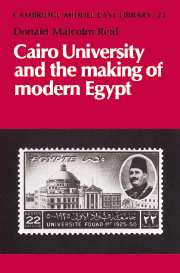Book contents
- Frontmatter
- Contents
- List of illustrations
- List of tables
- Acknowledgments
- Note on academic terminology and transliteration
- List of abbreviations
- Introduction
- Part I The private university, 1908–1919
- 1 Antecedents
- 2 Implementing the plan
- 3 Challenges and adjustments
- Part II The university and the liberal ideal, 1919–1950
- Part III In Nasser's shadow, 1950–1967
- Part IV The university since Nasser
- Conclusion and prospect
- Notes
- Select bibliography
- Index
3 - Challenges and adjustments
Published online by Cambridge University Press: 30 October 2009
- Frontmatter
- Contents
- List of illustrations
- List of tables
- Acknowledgments
- Note on academic terminology and transliteration
- List of abbreviations
- Introduction
- Part I The private university, 1908–1919
- 1 Antecedents
- 2 Implementing the plan
- 3 Challenges and adjustments
- Part II The university and the liberal ideal, 1919–1950
- Part III In Nasser's shadow, 1950–1967
- Part IV The university since Nasser
- Conclusion and prospect
- Notes
- Select bibliography
- Index
Summary
Life in the university when it first became available for Egyptians was like a perpetual feast or celebration, which started up every day when evening came. Crowds of students converged on the study rooms, rich and poor in endless diversity, at varying stages in their education. There was every variety of garb too. Some were very elegant and others threadbare with hardly two piastres to rub together. There were qadis, doctors, students, officials, and denizens of the noble Azhar.
Besides all these, there were others too, with only the scantiest pretensions to learning. They flocked to lectures and studies just to see and hear and enjoy themselves, as far as they could. With these throngs, the University rooms were cramped indeed, and with swollen numbers packed into class-rooms the professors had difficulty being heard. Some of them decided to give their lectures twice over…
The University was obliged to organise the entry into the class-rooms, admitting only those who showed a registration card. In this way they kept out a sizable number who were making their way into classes as though they were public lectures.
All the pleading of Taha Husayn's friends could not get the blind student's servant-guide past the literalistic doorkeeper.
- Type
- Chapter
- Information
- Cairo University and the Making of Modern Egypt , pp. 44 - 68Publisher: Cambridge University PressPrint publication year: 1990

